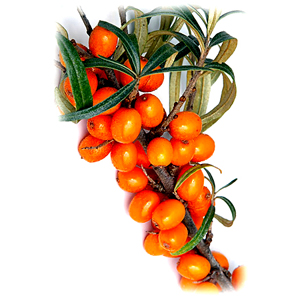No products
Sea Buckthorn syrup - 320g
Helps support immunity, in stomach ulcers, antioxidant and source of huge complex of vitamins...
![]()
Description of herb
Sea buckthorn is a hardy, deciduous or evergreen shrub that can grow between 2 and 4 m high (between 7 and 13 ft). It has a rough, brown or black bark and a thick, grayish-green crown. The leaves are alternate, narrow and lanceolate, with silvery-green upper faces. It is dioecious, meaning that the male and female flowers grow on different shrubs. The sex of seedlings can only be determined at the first flowering, which mostly occurs after three years. The male inflorescence is built up of four to six apetalous flowers, while the female inflorescence normally consists of only one apetalous flower and contains one ovary and one ovule. Fertilization occurs solely via wind pollination, which is why male plants need to be planted near the female plants to allow for fertilization and fruit production.
The oval or lightly roundish fruits grow in compact grapes varying from pale yellow to dark orange. Individual fruits weigh between 270 and 480 mg and contain high amounts of vitamin C, vitamin E, carotenoids, flavonoids and health-beneficial fatty acids, as well as higher amounts of vitamin B12 than other fruits.
The plants have a very developed and extensive root system, and the roots live in symbiosis with nitrogen-fixing Frankia bacteria. The roots also transform insoluble organic and mineral matters from the soil into more soluble states. Vegetative reproduction of the plants occurs rapidly via root suckers.
Healing effects
Vitamin B - B1, B2, B6, B3 (nicotinamide, vitamin PP) contained in sea buckthorn maintains the harmonious function of the central nervous system, B9 (folic acid) helps the synthesis of nucleic acids that favorably affect hematopoiesis, growth and fetal development.
It has 10 times more vitamin C than orange and many other medicinal substances. The researchers say that the recommended daily dose of vitamin C is covered by a single berry.
Vitamin D contributes to the proper growth and development of bones and at the same time regulates the amount of calcium and phosphorus in the blood.
Vitamin E is an antioxidant and protector of essential fatty acids. It is used for diseases such as male sterility, muscular dystrophy and also for cardiovascular disorders.
Vitamin K is responsible for maintaining blood clotting. In the absence of timely medical assistance, bleeding may occur due to a malfunction or lack of platelets in the individual's blood.
Sea buckthorn acts as - a biogenic stimulator, generally strengthens the body - has antidepressant and anti-stress effect - occupies a prominent position in eliminating gastrointestinal problems - dissolving mucus - lowers cholesterol - helps break down toxic substances in the body - regenerates skin epithelium (frostbite and any burns) successfully used on
- gynecological problems
- cold
- rhinitis
- sinusitis
is suitable for
- strengthening eyesight
- hemorrhoids
- eczema
- Acne
- cold sores
It helps with these diseases and problems
gynecological inflammatory diseases, erosion of the cervix, inflammation of the vagina, inflammation of the lining of the cervix. A good therapeutic effect is also observed in inflammatory diseases of the rectum inflammation of the nasal mucosa, inflammation of the larynx, pharynx and sore throat inflammatory gum disease and periodontitis gastrointestinal diseases, especially gastric and duodenal ulcers and gastritis. This applies especially to the spring and autumn, when the manifestations of these diseases worsen.
Active substances
Sea buckthorn is a natural concentrate of fatty acids, vitamins - E, F, P, K, A, B and C - and mainly carotene, which it contains several times more than carrots and pumpkins.
The high content of vitamin E, which is an important antioxidant, prevents vascular sclerosis and thus reduces the risk of myocardial infarction.
Properties
Antioxidant, anti-inflammatory, immunostimulatory, expectorant.
Recommended at
Per oral use helps in these diseases and troubles
- prevention of skin infections
- vision improvement
- slowing down the aging process
- asthma
- angina pectoris
- hyperlipidemia (high cholesterol)
- slows down the decline in mental dexterity associated with aging
- reduces the side effects of cancer treatment
- diseases of the gastrointestinal tract, including ulcers
- upset stomach
- dyspepsia
- constipation
Dosing
Adults and children from 12 years: 10 ml 3 times a day
Children from 3 to 12 years: 2-3 times a day 10 ml (1 ml = 15 drops)
The glycemic index of our fructose syrups is approximately 25 per 100 ml.
Side effects
There are no known cases of overdose or any adverse effects but not suitable for children under three years, pregnant and breastfeeding mothers.
REMEMBER: Tell all your health care providers about any complementary health practices you use. Give them a full picture of what you do to manage your health. This will help ensure coordinated and safe care.


